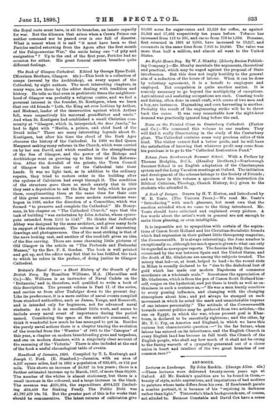The Book of Glasgow Cathedral. Edited by George Eyre - Todd. (Morrison
Brothers, Glasgow. 42s.)—This book is a collection of essays (several by the Archbishop), on every aspect of the 'Cathedral, by eight authors. The most interesting chapters, in many ways, are those by the editor dealing with tradition and history. He tells us that even in prehistoric times the neighbour- hood of Glasgow was probably a religious centre, and we feel a personal interest in the founder, St. Kentigern, when we learn that our old friends "Loth, the King set over Lothian by Arthur, and Medrant, leader of the insurrection against which Arthur fell, were respectively his maternal grandfather and uncle." And when St. Kentigern had established a small Christian com- munity at "Glasgow, which is, interpreted, the dear family," he had to fight with "Merlin, a prince, and chief bard of the Druid tribe." There are many interesting legends about St. Kentigern, but after his time the cloud of the Dark Ages obscures the history of the Cathedral. In 1069 we find Queen Margaret making many reforms in the Church, which were carried on by her son David, and which resulted in the strengthening of the See of Glasgow, and the power of the Bishops and Archbishops went on growing up to the time of the Reforma- tion. After the downfall of the priests, the Town Council of Glasgow took the care of the Cathedral into their hands. It was no light task, as in addition to the ordinary repairs, they tried to restore order in the building after the cyclone of Calvinism had swept through it. The condition of the structure gave them so much anxiety that in 1609 they sent a deputation to ask the King for help, which he gave them, complimenting them at the same time for their care of this great monument. The more modern restorations were begun in 1836, under the direction of a Committee, which was formed "to preserve and complete the Cathedral." Mr. Honey- man, in his chapter on "The Cathedral Church," says that the task of building "was undertaken by John Achaius, whose episco- pate extended from 1115 to 1147." He thinks that Jedburgh Abbey was designed by the same architect, and gives many facts in support of the statement. The volume is full of interesting drawings and photogravures. One of the most striking is that of the nave looking east, and another of the rood-loft gives an idea of the fine carving. There are some charming little pictures of Old Glasgow in the article on "The Prebends and Prebendal Manses," by the Rev. F. S. Gordon. The book is well printed and got up, and the editor may feel that he has fulfilled the task to which he refers in the preface, of doing justice to Glasgow Cathedral.






































 Previous page
Previous page